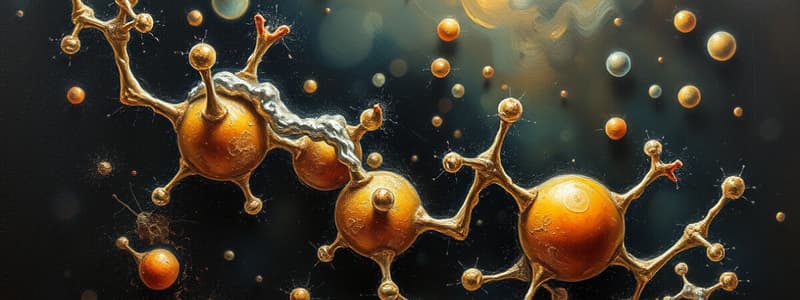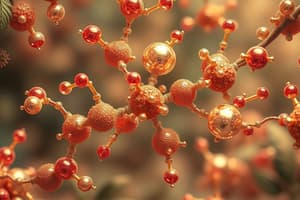Podcast
Questions and Answers
Triglycerides, phospholipids, fats, and waxes are classified as _____, nonpolar hydrophobic macromolecules.
Triglycerides, phospholipids, fats, and waxes are classified as _____, nonpolar hydrophobic macromolecules.
lipids
Which of the following are configurations of carbohydrates?
Which of the following are configurations of carbohydrates?
- Polysaccharides (correct)
- Proteins
- Lipids
- Monosaccharides (correct)
In DNA, adenine always base pairs with______, and cytosine always base pairs with _____
In DNA, adenine always base pairs with______, and cytosine always base pairs with _____
thymine; guanine
Put the four levels of protein organization in order of complexity from least to most complex.
Put the four levels of protein organization in order of complexity from least to most complex.
The pathways that electrons follow as they rotate around the nucleus of an atom are called _____
The pathways that electrons follow as they rotate around the nucleus of an atom are called _____
A membrane is composed of which of the following?
A membrane is composed of which of the following?
______ ______ are long hydrocarbon molecules with a carboxyl group at one end.
______ ______ are long hydrocarbon molecules with a carboxyl group at one end.
Two _____ are combined to make a disaccharide.
Two _____ are combined to make a disaccharide.
A ______ bond is a chemical bond that involves the sharing of electrons between two atoms.
A ______ bond is a chemical bond that involves the sharing of electrons between two atoms.
Which of the following are components of a nucleotide?
Which of the following are components of a nucleotide?
The number of electrons in the outermost shell of an element is known as its _____
The number of electrons in the outermost shell of an element is known as its _____
Biochemistry is the study of organic macromolecules found in the following families:
Biochemistry is the study of organic macromolecules found in the following families:
The amino acid monomers of a protein molecule are bonded to each other by:
The amino acid monomers of a protein molecule are bonded to each other by:
Triglycerides are composed of _____ and _____
Triglycerides are composed of _____ and _____
MRNA encodes the order and type of _____
MRNA encodes the order and type of _____
TRNA carries _____ to the ribosome during protein synthesis.
TRNA carries _____ to the ribosome during protein synthesis.
RRNA is a structural component of _____
RRNA is a structural component of _____
The _____ of an atom is its ability to attract electrons.
The _____ of an atom is its ability to attract electrons.
ATP is a molecule containing the nitrogenous base _____, ribose, and three phosphates.
ATP is a molecule containing the nitrogenous base _____, ribose, and three phosphates.
Lipids encompass which four of the following groups of compounds?
Lipids encompass which four of the following groups of compounds?
Match the following subatomic particles with their charges:
Match the following subatomic particles with their charges:
Which of the following are examples of compounds found in living things?
Which of the following are examples of compounds found in living things?
Carbon has four electrons in its outer shell that can be used to form _____ bonds with four other atoms.
Carbon has four electrons in its outer shell that can be used to form _____ bonds with four other atoms.
The term 'carbohydrate' refers to the fact that most compounds in this class are combinations of which element and which molecule?
The term 'carbohydrate' refers to the fact that most compounds in this class are combinations of which element and which molecule?
A _____ is a water-repellent compound that is classified as an ester that contains a long chain alcohol and a saturated fatty acid.
A _____ is a water-repellent compound that is classified as an ester that contains a long chain alcohol and a saturated fatty acid.
Match the terms with their definitions:
Match the terms with their definitions:
Polysaccharides contribute to or serve as?
Polysaccharides contribute to or serve as?
Nucleotides are composed of the 3 subunits:
Nucleotides are composed of the 3 subunits:
Which of the following are examples of organic molecules?
Which of the following are examples of organic molecules?
The term _____ is derived from the fact that most compounds of this chemical class are synthesized from the combination of carbon and water.
The term _____ is derived from the fact that most compounds of this chemical class are synthesized from the combination of carbon and water.
Match the type of chemical reactions with their descriptions:
Match the type of chemical reactions with their descriptions:
____ like cellulose is a polymer of glucose but in this case, it is a branching chain.
____ like cellulose is a polymer of glucose but in this case, it is a branching chain.
An _____ is a pure chemical substance with its own characteristic atomic structure and chemical properties.
An _____ is a pure chemical substance with its own characteristic atomic structure and chemical properties.
A ______ is a distinct chemical substance that results from the combination of two or more atoms, which is more specifically termed a compound if these are combinations of different elements.
A ______ is a distinct chemical substance that results from the combination of two or more atoms, which is more specifically termed a compound if these are combinations of different elements.
A _____ is a molecule that is a combination of two or more different elements.
A _____ is a molecule that is a combination of two or more different elements.
Flashcards are hidden until you start studying
Study Notes
Lipids
- Lipids include triglycerides, phospholipids, fats, and waxes, characterized as nonpolar hydrophobic macromolecules.
- Triglycerides consist of fatty acids and glycerol.
- Phospholipids are key components of cell membranes, along with proteins.
Carbohydrates
- Carbohydrates exist in two primary configurations: monosaccharides and polysaccharides.
- Polysaccharides serve various functions such as energy storage and structural support.
DNA Base Pairing
- In DNA, adenine pairs with thymine (A-T), and cytosine pairs with guanine (C-G).
Protein Structure
- Proteins have four levels of organization: primary (amino acid sequence), secondary (alpha helices and beta sheets), tertiary (3D shape), and quaternary (multiple polypeptide chains).
Atomic Structure
- Orbitals are pathways for electrons surrounding an atom's nucleus.
- Electronegativity measures an atom's ability to attract electrons.
Nucleotides
- Nucleotides consist of three components: a phosphate group, a pentose sugar, and a nitrogenous base.
- ATP (adenosine triphosphate) is a nucleotide that serves as energy currency, containing adenine, ribose, and three phosphates.
Electron Configuration
- Valence refers to the number of electrons in the outermost shell of an element.
- Elements form covalent bonds by sharing electrons, which is crucial for the stability of compounds.
Biochemistry
- Biochemistry studies organic macromolecules: lipids, proteins, carbohydrates, and nucleic acids.
- Organic molecules include water, proteins, and carbohydrates.
Other Compound Types
- Fatty acids are long hydrocarbon molecules ending with a carboxyl group.
- Waxes are water-repellent compounds classified as esters containing long-chain alcohols and saturated fatty acids.
Chemical Reactions
- Reactants are molecules entering a reaction, and products are molecules resulting from a chemical reaction.
- Three reaction types include decomposition, exchange, and synthesis.
Biological Polymers
- Starch is a polysaccharide and polymer of glucose characterized by branching chains, unlike cellulose.
Elements and Molecules
- An element is a pure chemical substance with specific atomic structure and properties.
- A molecule is a distinct substance formed from the combination of two or more atoms, while a compound refers to a molecule made of different element types.
Studying That Suits You
Use AI to generate personalized quizzes and flashcards to suit your learning preferences.




